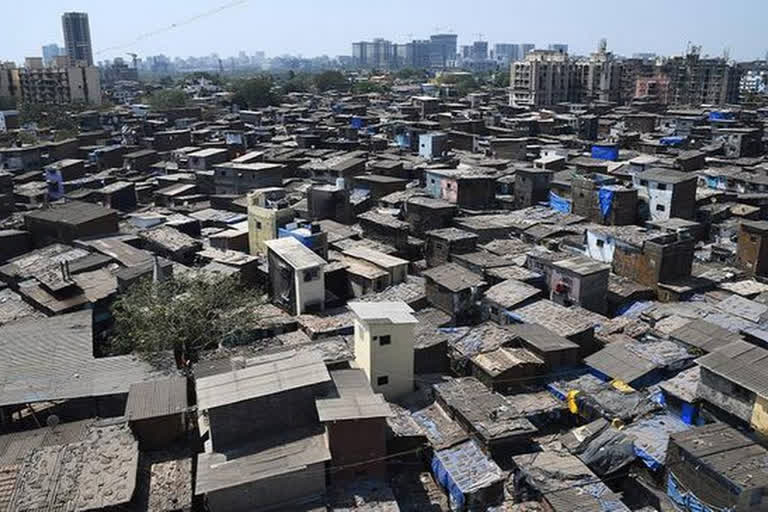Mumbai:Mumbai's Dharavi, which is one of the largest slums in Asia, reported nearly 1,400 COVID-19 cases in May, or a whopping jump of about 380 per cent from the April figures, adding to concerns of its residents.
However, the Brihanmumbai Municipal Corporation (BMC) claimed the situation has improved, and the spread of infection is under control in the slum area, where nearly 6.5 lakh people live in shanties located in congested settlements.
Narrow lanes and bylanes, small houses, unhygienic living conditions, common toilets and several other factors are responsible for the easy spread of COVID-19 in Dharavi, apart from non-adherence to social distancing norms, official said.
In April, 369 coronavirus cases were reported from Dharavi and the number rose to 1,771 by May-end, accounting for 4.4 per cent of the total COVID-19 cases detected in the city and indicating the extent and intensity with which the infection spread in the slum pocket.
Along with the high number of COVID-19 cases, Dharavi also reported 70 deaths due to the disease till May end, as compared to 18 deaths in April.
The COVID-19 outbreak was reported in Mumbai on March 11, and the first case of the disease was found in Dharavi's Dr Baliga Nagar area 20 days later, on April 1, setting the alarm bells ringing for the city administration.
The disease spread was initially slow in the area and it took over a fortnight for Dharavi to add 100 cases to its tally, and by May 3, it crossed the 500-mark.
Thereafter, COVID-19 cases went on increasing rapidly and in next 10 days, the number crossed the 1,000-mark on May 13 and 1,500-mark on May 23, as per official figures.
However, according to BMC officials, there has been a steady decline in the number of COVID-19 cases in Dharavi since the past one week. They said 18 new cases each were recorded on May 28 and May 30.
Of the total 1,771 cases in Dharavi so far, the highest 243 cases have been reported from Matunga Labour Camp area, followed by 116 and 86 cases in Kumbharwada and Mukund Nagar localities, respectively.
"Areas with maximum cases are identified and treated as high-risk zones' where door-to-door screening, fever camps, and contact-tracing is underway," a BMC official said.
ALSO READ: People concerned about expensive COVID-19 treatment at pvt hospitals: Survey
Kiran Dighavkar, assistant municipal commissioner of the G-north ward which covers Dharavi, said things have improved considerably in the slum area in the past few days and further improvement is expected in days to come.
"The doubling rate of cases in Dharavi has gone up to 31 days and the death rate has come down. After the first 60 deaths, the fatality rate has fallen considerably," he said.
In the first half of May, the number of cases in Dharavi was doubling in six days, and in two days in the first half of April.
Dharavi has a population of about 6.5 lakh and is spread over 2.5 sq km area. With its population density of 2,27,136 people per sq km, the city civic administration is making all efforts and working on a war footing to contain the spread of coronavirus.
Due to the huge number of COVID-19 cases in Dharavi, the G-north ward is on the top in the city with nearly 3,000 cases, out of the total 24 qwards in the city.
According to the BMC, over 75 per cent of the cases reported in Dharavi are of people in the age group of 21 to 60 years. Besides, 35 per cent of the cases are of those contracting infection within their families.
To contain the spread of COVID-19, the BMC has identified 13 'high risk' zones in Dharavi, an official said. The civic body has been ensuring the supply of food, groceries and medicine inside the high risk zones to restrict movement of anyone outside or within the area, he said.
According to the BMC, Dharavi has around 225 community toilets, 100 public toilets and 125 toilets built by the Maharashtra Housing and Area Development Authority.
"As hundreds of people use common toilets in the area, the risk of coronavirus spread is high, which is why these lavatories have to be cleaned regularly," an official said.
Dharavi has nine municipal dispensaries, 50 private clinics, apart from fever clinics. Altogether, 47,500 people from the high risk zones and 1.25 lakh residents of containment zones of Dharavi have been screened so far, as per the BMC figures.
They are among the nearly four lakh Dharavi residents who have been screened with the help of 24 private practitioners, the BMC said.
Several migrant labourers residing in Dharavi have already left for their native places by trains, buses and other modes of transport in the last one month.
PTI REPORT
